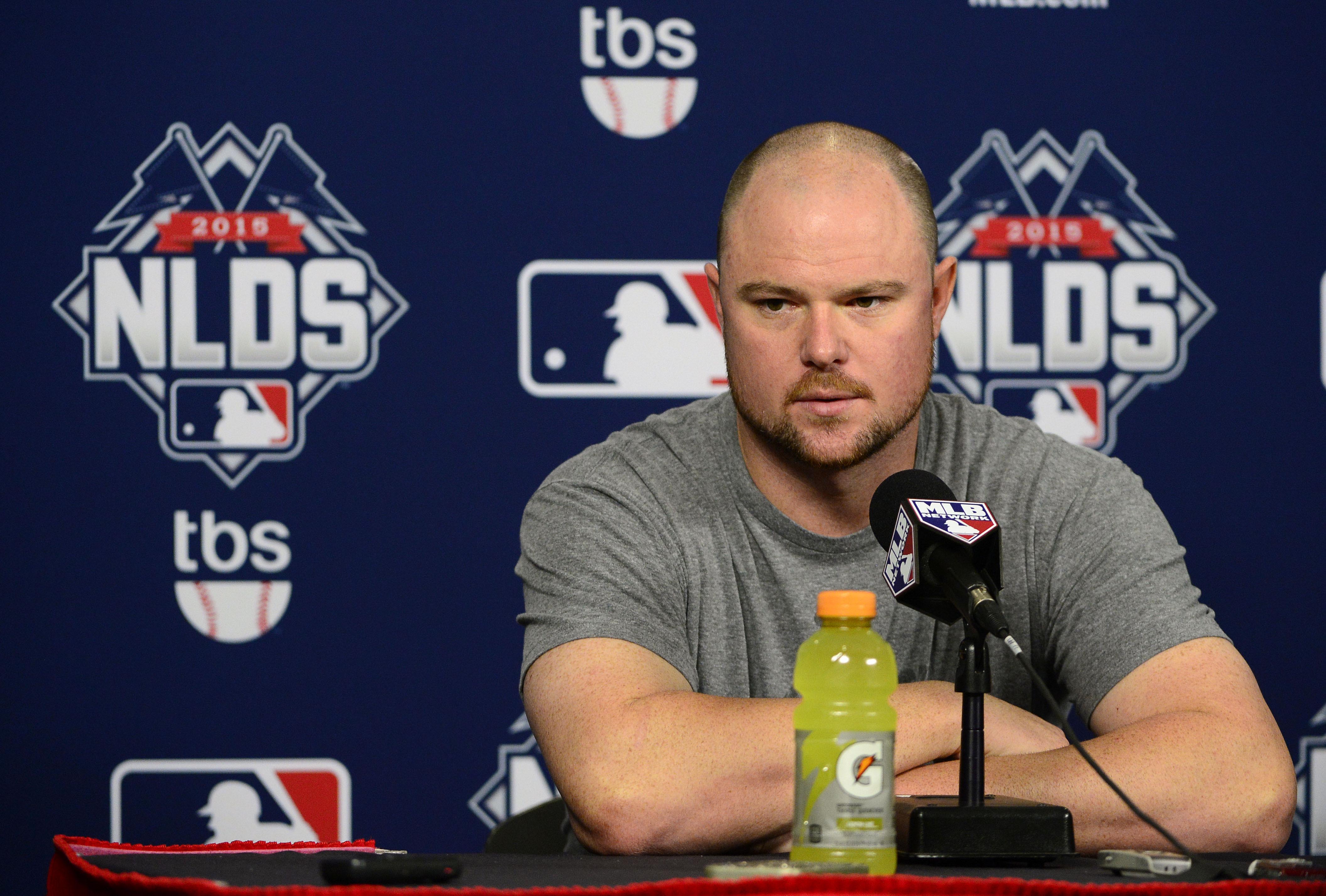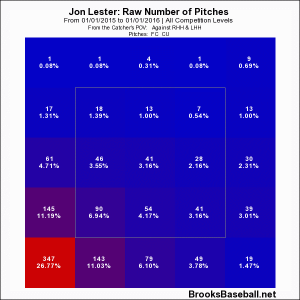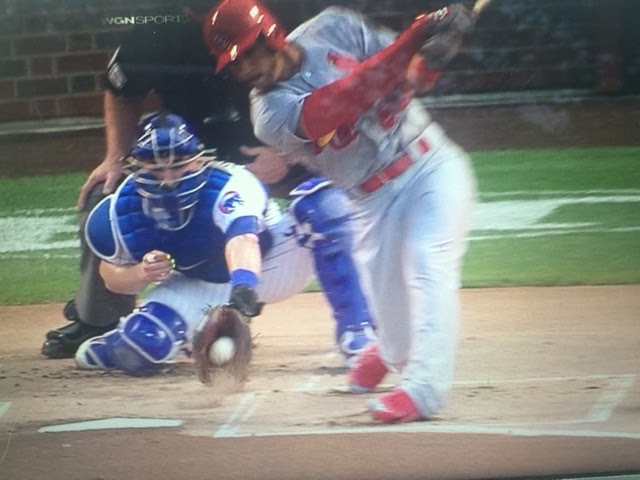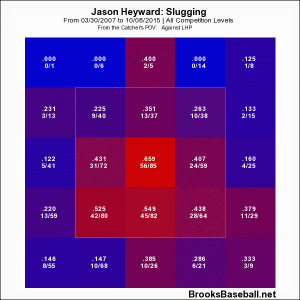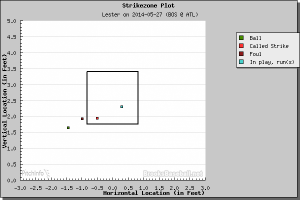Give me the (four-seam) fastball and I watch what I do with it
— Lil Bow Wow, paraphrased
On Opening Night, Jon Lester struggled to find a rhythm against the St. Louis Cardinals. In failing to make it through five innings, Lester allowed eight hits, all on his four-seam and cut fastballs, while Cardinals left-handed batters went 6-for-11 with a walk. It was an inauspicious beginning to what ended up being a typically strong Lester season. Now, almost six months to the day since that April night, Lester will take the mound against those same Cardinals in Game One of the NLDS. Baseball is great that way.
Lester made five starts against the Cardinals in 2015 and posted the following numbers:
| AVG Start | AVGGS | WHIP | ERA | K% | BB% | Whiffs | OPS | ISO | EXBH | BABIP |
| 6 1/3 IP | 59 | 1.117 | 2.59 | 26.8% | 7.9% | 55 | .629 | .137 | 9 | .275 |
By Game Score, his fifth- and sixth-best performances came against the Cardinals, including his September 9th start at St Louis. His May 6th start at St. Louis was one the team’s great forgotten individual efforts of the season. The Cubs entered losers of four straight, including the first two games of the series, and Lester responded by posting the following line:
7.0 IP, 7 H, 6 K, 2 BB, 4 R (1 ER), 107 pitches
By Game Score (57), it was only his fifth best start in May, but on a humid Midwestern night he battled to a victory.
What stands out is that against Lester, the Cardinals were a high strikeout team and largely devoid of power, averaging just 1.8 extra-base hits per game (versus 2.86 extra-base hits per game during regular season).
Of course, Lester is a different pitcher than he was in April, and even July, so we will take a quick and dirty look (phrase trademark pending to Rian Watt, Andrew Felper, and BP Wrigleyville) at how Lester attacked the Cardinals overall and in September, his approach to his five September starts, reasons to be wary of Jason Heyward, and a prediction of Lester’s game plan on Friday night in St. Louis.
The Cardinals, in Brief
I will keep this section brief, as our talented Baseball Prospectus and BP Wrigleyville staffs have analyzed the Cardinals in more thorough and eloquent detail. I do need to touch on their offense briefly, however, as it does inform how Lester will plan his attack.
Against left-handed pitchers, the Cardinals hit just .230/.307/.355 as a team, which puts them about 15 percent below the league average, according to sOPS+. Also against left-handers, they ranked bottom three in the NL in strikeout rate, on-base percentage, and OPS, but their power numbers (slugging percentage, ISO, and home-run-to-flyball ratio) were closer to the middle of the pack.
The Cardinals were not an overly patient team, with just one player (Matt Carpenter) ranking among the NL’s top 30 in pitches per plate appearance (five Cubs hitters were in the top 30). The team ranks fifth in swing rate, third in swing rate on pitches inside the strike zone, and fifth in swing rate outside of the strike zone. They are hacking, and in September, Lester consistently came over the plate early with his four-seam fastball to get ahead in the count.
If Lester can get ahead and force the Cardinals to expand their strike zone, he has a game plan already put in place for him. It’s something that has already worked for him and could be an effective plan Friday evening: bury the curve and cutter down and in to right-handed batters, and low and away to left-handed batters:
How Lester Approached the Cardinals
| Pitch | Frequency | AVG | SLP | K | Whiffs |
| Four-Seam | 48.0% | .225 | .375 | 12 | 18 |
| Cutter | 24.9% | .222 | .333 | 14 | 18 |
| Sinker | 6.4% | .111 | .111 | 0 | 2 |
| Curve | 12.6% | .200 | .400 | 6 | 9 |
| Change | 7.8% | .143 | .286 | 2 | 8 |
Lester’s cutter was his best strikeout pitch against the Cardinals. It accounted for 25 percent of all pitches, but 33 percent of whiffs and 35 percent of strikeouts. As we detail below, Lester pounded the cutter away from the Cardinals heavy left-handed hitting lineup. Expect it to be a favorite of his with two strikes.
However, it is really all about the four-seam fastball. Expect Lester to feature the pitch heavily. Of his five starts in which he threw the highest frequency of four-seam fastballs, three came against St. Louis, including both September starts. Given that, here is how their likely starters have fared against the pitch from left-handed pitchers in 2015:
| Player | % of Pitches seen from LHP | AVG | SLG | BIP% |
| Yadier Molina | 37.0% | .235 | .265 | 16,29% |
| Matt Adams | 22.2% | .200 | .400 | 13.64% |
| Stephen Piscotty | 33.1% | .308 | .615 | 10.34% |
| Kolten Wong | 38.0% | .268 | .293 | 14.37% |
| Matt Carpenter | 54.1% | .254 | .492 | 12.90% |
| Jhonny Peralta | 3.5% | .245 | .469 | 15.93% |
| Matt Holliday | 42.3% | .174 | .174 | 13.71% |
| Jason Heyward | 40.3% | .276 | .328 | 16.0% |
| Randal Grichuk | 31.6% | .293 | .567 | 25.58% |
Of the nine hitters considered, five slugged .400 or lower off of the four-seam, including three of five left-handed hitters. As a team, they were just adequate at putting the ball in play against the pitch. The Cardinals were simply not very productive against four-seam fastballs from left-handed pitchers, and Lester and David Ross are likely aware.
Lester’s curve usage will depend on his ability to get ahead early, as we will detail in the section below. If Adams or Piscotty start, Lester might by wary of going to his curve against either. On September 25, after seeing four consecutive cutters from Lester, Piscotty homered off a curve left over the plate. In Game Four of the 2014 NLDS, Matt Adams homered off Clayton Kershaw on a curve left over the plate. [Ed. Note: Lester won’t need to worry about Adams as manager Mike Matheny decided to keep him off the NLDS roster.]
Ok. Back to general trends. Why is it so important for Lester to get ahead of Cardinals hitters? The Cardinals offense was not productive when they fell behind (.205/.214/.308) or reached two strikes (.175/.247/.308). If Lester can get into 0-1 and 1-2 counts with his fastballs, he can stretch the strike zone with his curve and cutter. The Cardinals are a lefty-heavy lineup, and, as we’ve already discussed, Lester has made his bones burying his curve and cutter down and away from left-handers.
How Lester Approached September
As it relates to the postseason, there is much to be gleaned from Lester’s September, as he made his five starts in the midst of the playoff race, with three coming against St. Louis and Pittsburgh.
| Pitch | Overall Frequency | Ahead in CountLHH RHH | Behind in countLHH RHH | ||
| Four-Seam | 49.68% | 31% | 39% | 63% | 55% |
| Cutter | 23.55% | 34% | 24% | 26% | 25% |
| Sinker | 6.77% | 3% | 2% | 7% | 12% |
| Curve | 12.90% | 28% | 22% | 5% | 5% |
| Change | 7.1% | 3% | 12% | 0% | 3% |
Lester with two strikes in September:
| Pitch | Frequency w/ 2 strikes | K | AVG | SLG |
| Four-Seam | 37.44% | 11 | .039 | .039 |
| Cutter | 32.51% | 14 | .103 | .172 |
| Sinker | 4.93% | 2 | .200 | .400 |
| Change | 5.91% | 3 | .000 | .000 |
| Curve | 19.21% | 11 | .125 | .313 |
In his postseason career, Lester has gone to his big three pitches—four-seam, cutter, curve—a combined 88 percent of all pitches, which is about 11 percentage points above his regular season average. In September, he went to those pitches on 86 percent of all pitches. In short, Lester and Ross approached September like it was the postseason.
Lester threw at least 48 four-seam fastballs in all five September starts. Prior to September, he had reached that total in six of his first 27 starts, including two starts against the Cardinals. In September, Lester set a season high for both overall four-seam usage (49.68 percent) and first-pitch four-seam usage (62.42 percent) in a month. As you can see above, when he falls behind, he becomes extremely predictable and dependent on the four-seam fastball. That is a recipe for disaster.
Lester went to his cutter on just 23.55 percent of all pitches in September (below his 27.16 percent usage entering the month), but, as you can see above, used it to record 35 percent of his strikeouts. Lester went to his cutter consistently regardless of the count. It was his best pitch of the final month, with batters slugging .238 overall, and left-handers just .182.
Lester’s curve, statistically, was his best pitch this season, with opponents posting a .287 slugging percentage against the pitch (and just .191 for left-handed batters). Down the stretch, though, Lester was hesitant to throw his curve once he fell behind in the count, and his curve usage fell by three percentage points. Against the Cardinals, Lester will need to get ahead to set up the curve.
In recapping his dominant start July 6th, we wrote “After he (Lester) came inside with an 89-mph cutter to even the count at 2-2 to Tommy Pham leading off the game, Lester unleashed this 75-mph curveball in the dirt:
Lester and Miguel Montero had Pham thinking up and in, and got him to whiff on the curve for strike three … Lester is at his best when he is able to use his fastballs to set-up his curveball.”
The change also emerged in September, as Lester used his fastballs to set up three strikeouts with the pitch. In the season’s final month, with Lester pitching like it was October, he threw all five of his pitches early and late in the count, but relied primarily on the four-seam, cutter, and curve triumvirate.
Things to Watch For
Jason Heyward. It is a small sample size, but in his career against Lester, Heyward is 10-for-24 with a home run and four doubles.
This season, left-handed batters hit just .247/.282/.376 against Lester. They recorded just seven doubles (and 16 extra-base hits overall), but two came on cutters thrown to Jason Heyward. They were the only two extra-base hits to left-handed batters on cutters that Lester allowed in 2015.
Both cutters stayed over the plate, and as we wrote often in April and May, did not quite cut. As you can see below, against left-handed pitchers, Heyward does a remarkable job of covering the entire plate, especially the bottom half:
A left-handed pitcher needs to miss off the plate, either inside or outside. As we have covered in (too much?) detail this season, Lester’s struggles have come when he leaves his cutter and four-seam fastball over the plate.
Heyward’s home run off Lester came in May 2014, when he led off the game with a solo shot. Lester got ahead 1-2 by staying away with two four-seamers and a cutter, but then caught the plate with an 88-mph cutter:
In his July 6th start against St. Louis, Lester threw only one cutter in 10 pitches to Heyward, and he went 0-for-3 and made weak contact. Lester could face Heyward three times in Game One, and while his cutter will likely play a factor later in counts, it will be interesting to see if he goes to the pitch against Heyward.
Game One
Everything points to Lester throwing about 50 percent four-seam fastballs on Friday: his overall September, his September specifically against the Cardinals, his overall season against the Cardinals, and his postseason track record. The Cardinals will likely start five left-handed batters, and against left-handers in September, Lester threw four-seam fastballs on 79 percent of first pitches (21 percentage points above his season average). He needs to get ahead of Cardinals hitters, and the four-seamer is the pitch with which he does that best.
Ahead in counts and with two strikes, expect to see his four-seam and cutter in roughly equal measure, with his curve coming about 20 percent of the time. He needs to get ahead in the count to keep that curve as a viable pitch, as it has been effective since April. When Lester struggles early with his fastballs, he has a tendency to abandon the pitch.
If the four seam is not getting over early, expect Lester to stay with the pitch, but go to the cutter with increased frequency, mix in the sinker, and mostly abandon his curve and change. That was the disastrous story of Opening Night. If the cutter is not proving more effective, though, then it could be up to Kyle Hendricks to even the series on Saturday.
Lead photo courtesy Jeff Curry—USA Today Sports.
